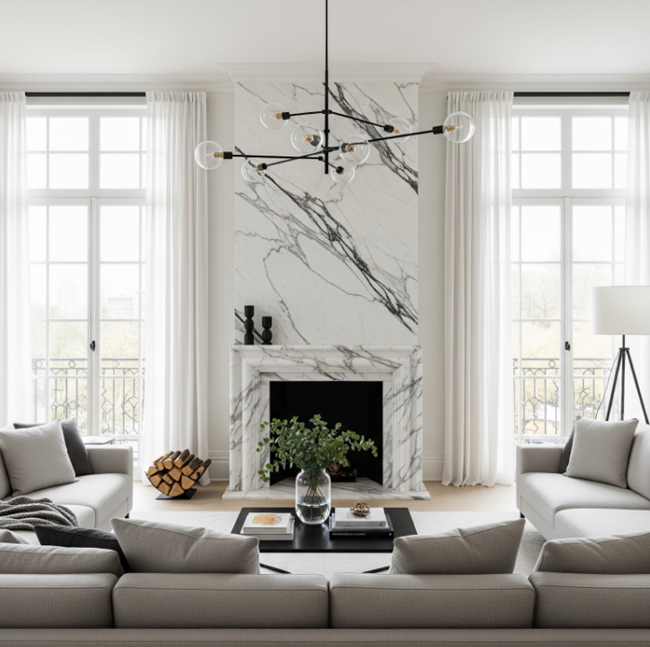TL;DR Summary: A minimalist living room combines intentional design with functional beauty, featuring neutral color palettes, multi-functional furniture, and carefully curated decor. Focus on quality over quantity, strategic spacing, and natural materials to create a calm, sophisticated space that serves your lifestyle without overwhelming it.
Introduction
A minimalist living room represents more than just an aesthetic choice—it’s a deliberate approach to creating sanctuary in your home. Research shows that 64% of millennials and Gen Z actively reduce their possessions, citing mental well-being and environmental concerns as primary motivations. Your living room serves as the heart of your home, and adopting minimalist principles can transform it into a serene, functional space that reduces stress while maximizing impact.

The appeal of minimalist design lies in its remarkable ability to strip away the unnecessary and highlight what truly matters. When you walk into a well-designed minimalist living room, you immediately feel a sense of calm. As architect Deborah Berke explains, “Minimalism is designing to allow the art, the books, the view, the people—whatever matters most to the inhabitant—to be the soul of the space.”
This comprehensive guide will walk you through every aspect of creating your perfect minimalist living room. You’ll discover actionable strategies for furniture selection, color schemes, lighting design, and the subtle details that transform ordinary spaces into extraordinary sanctuaries. Whether you’re starting from scratch or refining an existing space, these proven techniques will help you achieve the minimalist living room of your dreams.
I. What Defines a Minimalist Living Room?

A minimalist living room prioritizes essential elements, clean lines, and intentional design choices that create visual calm and functional efficiency. This approach eliminates clutter while maintaining warmth and personality through carefully selected pieces that serve both practical and aesthetic purposes.
The foundation of minimalist design rests on three core principles.
- First, every item must earn its place through function or meaningful aesthetic contribution.
- Second, open space becomes a design element itself, providing visual breathing room.
- Third, quality always trumps quantity—one exceptional piece outweighs multiple mediocre items.
Modern minimalism has evolved beyond stark white spaces. Designer Jordana Ashkenazi of Element One House notes that “Cozy minimalism is about balance, like calm, uncluttered spaces that still feel warm and lived-in.” This evolution acknowledges that minimalist spaces can embrace personality while maintaining their essential simplicity.
The shift toward minimalism reflects broader cultural changes. Market research indicates that customers increasingly prefer modern and minimalist living room furniture, attributed to the popularity of open floor plans and smaller living spaces where sleek, compact designs prove more practical.
Pro Tip: Start your minimalist transformation by photographing your current living room. Review the images objectively to identify which pieces genuinely add value versus those that simply fill space. This visual assessment often reveals clutter blind spots you’ve grown accustomed to ignoring.
Trending Post: 25 Easy Renter-Friendly Hacks On The Budget
II. How to Choose the Right Color Palette for Your Minimalist Living Room
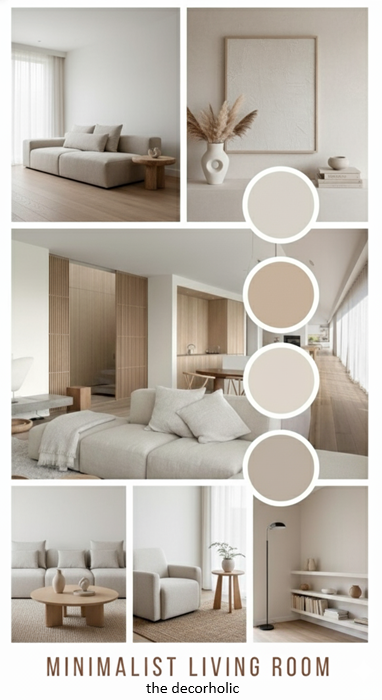
Neutral foundations paired with strategic accent colors create the hallmark minimalist aesthetic. Whites, beiges, soft grays, and warm earth tones establish visual calm, while carefully chosen accent hues prevent sterility and add personality without overwhelming the space.
Start with:
- a dominant neutral that covers 60% of your room—typically walls and large furniture pieces. This creates your canvas.
- Add a secondary neutral at 30% through additional furniture, rugs, or window treatments.
- Reserve the final 10% for accent colors that inject personality.
The 2025 minimalist palette extends beyond pure white. Warm beiges create inviting atmospheres, while soft grays offer contemporary sophistication. Design trends favor muted blues and warm beiges that introduce serene ambiance, enhanced by earthy elements like brass, stone, and wood that provide grounding warmth.
Consider these color strategies:
- Monochromatic schemes layer various shades of a single color for sophisticated depth
- Warm minimalism incorporates cream, taupe, and soft terracotta for approachable elegance
- Cool neutrals featuring gray, white, and black create crisp, contemporary environments
Experts suggest incorporating earth tones like browns and muted reds to bring grounding to contemporary spaces. These natural hues connect your interior to the outdoors while maintaining minimalist principles.
Pro Tip: Paint sample swatches directly on your walls in different lighting conditions. Colors transform dramatically between morning and evening light. Live with samples for at least three days before committing to ensure the shade maintains its appeal throughout various times and weather conditions.
Don’t Miss: How to Choose and Arrange an Area Rug in Your Home
III. Selecting Essential Furniture for Minimalist Living Rooms

Multi-functional, low-profile furniture with clean lines forms the backbone of minimalist living rooms. Choose pieces that combine exceptional craftsmanship with practical versatility, ensuring each item serves multiple purposes while maintaining visual simplicity.
Begin with your seating foundation. Select a sofa that balances comfort with streamlined design. Designer observations note curved sofas gaining popularity as they spring from organic shapes and earthy colors, feeling more cozy and intimate than traditional minimalist straight lines. However, classic rectangular sofas with simple silhouettes remain timeless choices.
Your furniture selection should follow a deliberate hierarchy:
Primary pieces anchor the room and receive daily use. Your sofa represents the largest investment and most significant visual element. Choose neutral upholstery in durable fabrics like linen, cotton, or performance materials. Low-profile designs create spaciousness by keeping sightlines open.
Secondary pieces provide functional support without competing for attention. Coffee tables should offer clean surfaces with optional hidden storage. Side tables need sufficient space for lamps and beverages while maintaining minimal footprints. Consider nesting tables that adapt to various needs.
Accent pieces inject personality through sculptural forms. Modern trends embrace furniture that transcends plain function, serving as art itself through sculptural and artistic forms with bold, asymmetrical lines. A single statement chair or unique floor lamp can elevate the entire space.
Modular and multi-functional furniture maximizes space and functionality, with designs easily reconfigured to suit different needs—perfect for modern living rooms. Storage ottomans double as seating and concealment. Extendable coffee tables adapt from intimate to entertaining mode.
Pro Tip: Before purchasing any furniture, measure your room precisely and create a scaled floor plan. Use painter’s tape to mark furniture footprints on your floor. Live with these outlines for several days, walking through your typical traffic patterns to ensure pieces won’t obstruct flow or create bottlenecks.
Don’t Miss: 10 Best Modular Sectional Sofas on Amazon
IV. Creating the Perfect Lighting Strategy
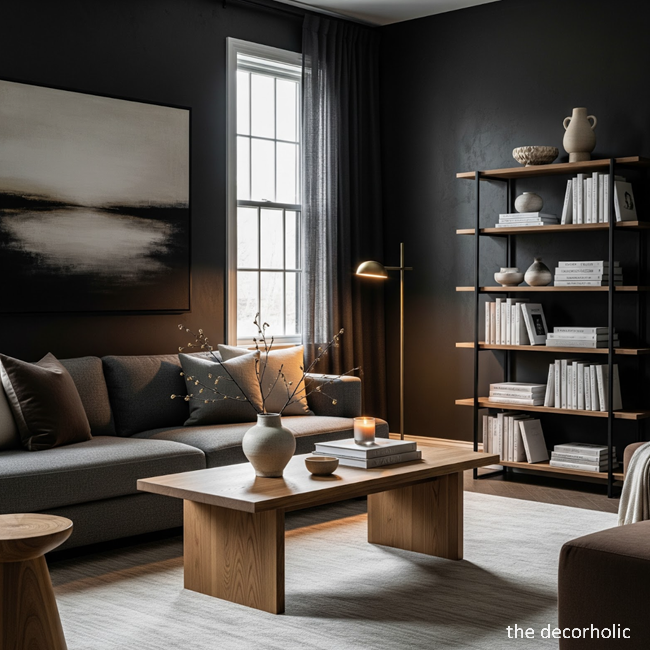
Layered lighting combining natural sources with strategic artificial fixtures establishes ambiance while maintaining functionality. Successful minimalist lighting balances abundant illumination with unobtrusive fixtures that complement rather than dominate the space.
Natural light serves as your primary source. Large windows that flood rooms with natural light remain a staple, now complemented with carefully curated artificial fixtures including LED pendants, sculptural floor lamps, and recessed lighting that create desired moods. Maximize daylight through sheer window treatments that filter harsh sun while maintaining brightness.
Build your artificial lighting in three layers:
Ambient lighting provides overall illumination. Recessed ceiling lights offer invisible sources that maintain clean lines. For rooms lacking recessed options, flush-mount fixtures with simple geometric shapes deliver general light without visual clutter. Dimmer switches prove essential for adjusting intensity throughout the day.
Task lighting supports specific activities. Reading requires focused illumination from adjustable floor lamps or swing-arm wall sconces. Desk areas need direct light that prevents eye strain. Choose fixtures with clean lines and neutral finishes that blend with your aesthetic.
Accent lighting highlights architectural features or artwork. Picture lights draw attention to wall art. Uplights create drama by washing walls with indirect glow. LED strips concealed under floating shelves add subtle dimension.
Design experts predict statement fixtures and architectural lighting will replace purely functional choices, with sconces, chandeliers, and sculptural floor lamps bringing dimension and warmth through layered task, accent, and ambient lighting.
Pro Tip: Install smart bulbs that allow color temperature adjustments. Use cooler tones (5000K) during morning hours to energize, then shift to warmer tones (2700K) in evening for relaxation. This simple technology transforms your room’s mood without changing fixtures or adding visual complexity.
Don’t Miss: Table Lamps: Your Guide to Decorating for Function and Flair
V. What Storage Solutions Work Best in Minimalist Living Rooms?

Concealed storage maintains visual simplicity while preventing clutter accumulation. Built-in cabinetry, furniture with hidden compartments, and strategic organization systems keep necessities accessible yet invisible, preserving the clean aesthetic.
Vertical storage maximizes space efficiency without sacrificing floor area. Floor-to-ceiling built-ins provide extensive capacity while appearing as architectural features rather than furniture. Floating shelves display carefully curated items at eye level, with closed storage below hiding everyday clutter.
Implement these proven storage strategies:
- Media centers with closed cabinetry conceal electronics and cables
- Ottoman storage combines seating with hidden capacity for blankets and remotes
- Console tables with drawers offer display surfaces plus concealed organization
- Modular systems adapt as needs change, growing or shrinking with your life
Multi-functional pieces like storage ottomans or coffee tables that double as desks offer practical solutions for limited spaces while maintaining minimalist aesthetics. Every storage piece should serve dual purposes—never sacrifice function for appearance or vice versa.
Consider the following:
- Closed storage for 80% of items to maintain visual calm,
- Reserving open display for the 20% that adds beauty or frequently gets accessed.
This ratio prevents the sterile feeling of complete concealment while avoiding the chaos of excessive display.
Pro Tip: Implement the “one in, one out” rule for items entering your living room. When you acquire something new, remove something old. This prevents gradual accumulation that slowly erodes your minimalist aesthetic. Schedule quarterly assessments where you evaluate whether each visible item still serves its purpose or deserves its place.
Don’t Miss: 9 Small Powder Room Genius Hacks
VI. How to Incorporate Texture Without Adding Clutter

Layering varied textures creates visual interest and warmth while maintaining minimalist principles. Natural materials, fabric variations, and surface contrasts add depth without introducing visual chaos or physical clutter.
Texture provides the secret ingredient that prevents minimalist spaces from feeling cold or sterile. Your eye craves variety—texture delivers that variety through touch and light interaction rather than color or pattern.
Build texture through these elements:
Natural materials offer inherent textural richness. Wood grain adds warmth through variation. Stone surfaces provide weight and permanence. Leather develops character through aging. Linen fabrics introduce subtle organic texture. Each material contributes tactile and visual interest without busy patterns.
Fabric layering creates cozy sophistication. A chunky knit throw draped over smooth leather upholstery creates contrast. Velvet pillows against linen cushions add luxury. Wool rugs under sleek furniture ground the space. Mix smooth with rough, soft with structured.
Architectural texture leverages existing features. Exposed brick provides instant character. Wood beams add dimensional interest. Plaster walls offer subtle variation. Even painted drywall develops texture through sheen choices—matte absorbs light for calm, while satin reflects it for vitality.
Pro Tip: Limit yourself to three to four different textures per room to maintain cohesion. Choose one dominant texture for 50% of surfaces, two supporting textures at 25% each, and one accent texture for final details. This formula creates richness without overwhelming the minimalist foundation.
Trending Post: Best Jewel Tone Paint Colors for a High-End Home Makeover
VII. Selecting and Displaying Artwork in Minimalist Spaces

A few carefully chosen pieces create focal points without overwhelming the space. Large-scale artwork makes bold statements, while thoughtful placement ensures each piece receives attention and contributes to the overall composition.
In minimalist living rooms with limited items, artwork adds personality and transformation without consuming surface space, making the right piece truly impactful. One exceptional artwork commands more attention than a gallery wall of mediocre prints.
Follow these selection principles:
Scale appropriately for your wall dimensions. A single large piece (at least two-thirds the width of your sofa) creates drama and sophistication. Small artworks get lost on expansive walls. When in doubt, size up rather than down—minimalist spaces provide the breathing room for bold scale.
Choose simple frames that complement without competing. Clean-lined frames in black, white, natural wood, or metal maintain focus on the artwork itself. Mat boards in neutral tones provide separation from walls. Avoid ornate frames that contradict minimalist principles.
Limit quantity to maintain impact. Three pieces maximum in most living rooms suffices. One statement piece above the sofa anchors the space. A pair of complementary works flanking a doorway or fireplace creates symmetry. More than five pieces risks cluttering the visual field.
Consider content that aligns with minimalist sensibilities. Abstract compositions work beautifully. Black and white photography offers timeless appeal. Simple line drawings provide elegance. Nature imagery connects to organic principles. Avoid busy scenes that fragment attention.
Pro Tip: Hang artwork at eye level—typically 57-60 inches from floor to center. In seating areas, position pieces relative to furniture rather than room height, ensuring they integrate with the seated sightline. Use painter’s tape to mock up placement before committing holes to walls.
Don’t Miss: How To Create a Dining Room Gallery Wall
VIII. Bringing Nature Indoors: Plants in Minimalist Living Rooms

Strategic plant placement adds life and air quality benefits without creating visual clutter. Choose architectural specimens with sculptural forms, and display them in simple containers that complement your overall aesthetic.
Bringing the outdoors in remains a key tenet of minimalist design, with 2025 continuing this tradition. Plants soften hard edges, purify air, and introduce organic elements that prevent spaces from feeling too manufactured.
Select plants with intention:
Large floor plants
Make dramatic statements with minimal quantity. A fiddle leaf fig or bird of paradise becomes sculptural art. Snake plants offer vertical interest with striking form. Monstera deliciosa provides bold foliage that commands attention. One large specimen often exceeds the impact of multiple small plants.
Medium tabletop plants
Add life to surfaces without overwhelming them. Peace lilies offer elegant blooms. Pothos cascade gracefully from shelves. Rubber plants provide glossy architectural leaves. Group odd numbers (three or five) for visual balance.
Low-maintenance varieties
Suit minimalist lifestyles. ZZ plants tolerate neglect. Succulents require minimal care. Cast iron plants survive low light. Air plants need no soil. Choose species matching your commitment level and lighting conditions.
Container selection matters equally. White ceramic pots maintain neutral palettes. Natural woven baskets add texture. Simple black containers create bold contrast. Concrete planters offer industrial edge. Avoid busy patterns or bright colors that compete for attention.
Pro Tip: Match your plant’s mature size to available space. Research growth patterns before purchasing—that cute tabletop plant may reach ceiling height within two years. Consider plants’ light and humidity requirements relative to your room’s conditions to ensure long-term success without constant maintenance or replacement.
Also: Expert Plant Styling Tips for a Stunning Home

IX. Common Minimalist Living Room Mistakes to Avoid

Understanding frequent pitfalls prevents costly errors and ensures your space achieves true minimalist elegance. Avoiding these mistakes saves time, money, and the frustration of living with design decisions that don’t serve your needs.
Many approach minimalism as pure subtraction—removing everything until rooms feel empty and cold. This misses the philosophy entirely. Interior designer Albert Hadley notes, “The essence of interior design will always be about people and how they live,” emphasizing that minimalism serves life rather than existing as sterile aesthetic exercise.
Watch for these missteps:
Prioritizing aesthetics over comfort creates showrooms rather than living spaces. That sculptural chair looks stunning but proves miserable for actual sitting. The low-profile sofa appears sleek but offers no back support. Form and function must balance—test furniture thoroughly before purchasing.
Using only white results in sterile, impersonal environments. While white serves as an excellent foundation, spaces need warmth through varied neutrals, natural materials, and strategic textures. Don’t mistake “minimal” for “monochrome.”
Eliminating all personality strips away the soul. Your home should reflect who you are. Display meaningful items rather than generic decor. Travel souvenirs, family heirlooms, or personal artwork add character without creating clutter when thoughtfully curated.
Ignoring scale and proportion disrupts visual harmony. Furniture too small floats awkwardly in space. Pieces too large overwhelm the room. Area rugs that barely extend beyond furniture look stingy—they should extend 12-18 inches beyond each side.
Forgetting practical needs for idealism creates frustration. You need adequate seating for guests. Remote controls require storage. Lighting must support reading. Design around your actual lifestyle rather than aspirational images.
Pro Tip: Live in your partially furnished space for two weeks before adding final pieces. You’ll discover which practical needs emerged that weren’t obvious initially. This patience prevents purchases you’ll regret and ensures every addition genuinely enhances your daily life rather than theoretical aesthetic.
Don’t Miss: 10 Best Ways For Adding Charm and Character To Your Home
X. Sustainable and Eco-Friendly Minimalist Design Choices

Environmentally conscious materials and practices align perfectly with minimalist philosophy. Quality pieces built to last reduce consumption, while sustainable materials minimize environmental impact without sacrificing aesthetic appeal.
Minimalist living rooms increasingly spotlight sustainable materials like bamboo, cork, and reclaimed wood for their earth-friendly nature and understated elegance. This approach makes statements about values while creating beautiful environments.
Embrace these sustainable strategies:
Choose quality over quantity by investing in well-crafted pieces built to last decades rather than trendy items requiring frequent replacement. Solid wood furniture ages beautifully. Metal frames prove virtually indestructible. Natural fibers like cotton and wool withstand years of use. The highest quality ultimately costs less through longevity.
Seek sustainable materials from responsible sources. FSC-certified wood ensures forest stewardship. Organic cotton avoids pesticides. Bamboo grows rapidly and renews quickly. Recycled metals reduce mining impact. Cork harvesting doesn’t harm trees. Low-VOC paints improve indoor air quality.
Consider secondhand options that give existing pieces new life. The second-hand furniture market reached $29.80 billion by 2024, driven by environmental and sustainability concerns. Vintage furniture offers quality craftsmanship and unique character while preventing waste.
Support local artisans who create durable, timeless pieces rather than mass-produced items shipped globally. Local purchasing reduces transportation emissions while supporting community economies and craftsmanship traditions.
Pro Tip: Calculate cost per year of use rather than upfront price when evaluating furniture. A $2,000 sofa lasting 20 years costs $100 annually. A $500 sofa requiring replacement every five years costs the same while generating more waste. Quality purchases prove economical and ecological over time.
Also: A Guide to the Best Flea Market Finds for Home Decoration
XI. How to Maintain Your Minimalist Living Room Long-Term

Consistent habits and systems prevent clutter creep and preserve your minimalist aesthetic. Regular maintenance routines keep spaces functioning beautifully while preventing the gradual accumulation that undermines minimalist principles.
Minimalism requires ongoing commitment rather than one-time achievement. Without intentional maintenance, possessions slowly accumulate until you’re back where you started. Implement systems that make maintenance automatic rather than requiring constant willpower.
Establish these routines:
Daily resets return everything to its designated place each evening. Spend five minutes before bed returning items to proper storage, folding throws, plumping pillows, and clearing surfaces. This prevents small messes from compounding into overwhelming chaos.
Weekly assessments identify potential issues before they escalate. Scan for items that don’t belong in the living room. Notice whether mail has accumulated. Check if decorative items still serve their purpose or have become invisible fixtures you no longer notice.
Monthly deep cleaning maintains the pristine quality minimalist spaces require. Dust surfaces thoroughly—minimalist rooms showcase dust more obviously than busy ones. Vacuum under furniture. Clean windows to maximize natural light. Refresh textiles.
Quarterly edits evaluate whether items still earn their place. Seasonal changes might require swapping throws or pillows. Assess whether books displayed still interest you. Consider whether artwork still resonates. Remove anything that no longer contributes meaningfully.
Pro Tip: Photograph your living room when it looks perfect. Save this image as your phone background or print it for reference. When the space begins feeling off or cluttered, compare current state to your ideal photo. This visual reminder quickly reveals what needs adjustment to return to your desired aesthetic.
Most Popular Post:
Interior Design Style Quiz
Timeless Paint Colors That Never Go Out of Style
Create Your Perfect Ergonomic Home Office: A Complete Guide
Must-Have Accessories for Guys: The Secret to a Stylish Space
Modular Sofas for Small Spaces: Brilliant Solutions for Compact Living
XII. Key Takeaways
Creating a minimalist living room transforms your daily life by establishing a calm, intentional environment that reduces stress and amplifies what matters most. Success comes from understanding that minimalism isn’t about deprivation—it’s about curation. Every piece you include should serve a purpose, provide beauty, or ideally both.
Start with neutral foundations and build through texture rather than quantity. Invest in quality furniture that combines function with timeless design. Layer lighting to create ambiance and utility. Conceal clutter while displaying meaningful items. Choose sustainable materials that honor your values and the environment.
Remember that your living room should reflect your life rather than magazine pages. Allow personality through carefully selected pieces that tell your story. Comfort matters as much as aesthetic—a beautiful room that doesn’t serve your actual needs fails the fundamental test of good design.
The minimalist philosophy asks one essential question: Does this add value to my life? Let that guide every decision, from major furniture purchases to small decorative objects. When you commit to this intentional approach, your living room becomes more than a space—it becomes a sanctuary that supports and enriches your daily experience.
Ready to begin your transformation? Start with one area—perhaps clearing your coffee table or editing bookshelf displays. Build momentum through small wins rather than attempting complete overhauls. Your perfect minimalist living room emerges through deliberate, thoughtful choices made over time.
Minimalist Living Room-Frequently Asked Questions (FAQ)
Q: How much does it cost to create a minimalist living room?
A: Minimalist living rooms span all budgets. You might spend $2,000-$5,000 for basic quality pieces or $10,000+ for premium furniture and finishes. The key is buying fewer, higher-quality items rather than filling space with inexpensive pieces. Start with essentials—sofa, coffee table, lighting—then add thoughtfully over time as budget allows.
Q: Can I have a minimalist living room with kids or pets?
A: Absolutely. Choose durable, washable fabrics like performance linen or microfiber. Select furniture with simple lines that clean easily. Implement robust storage systems for toys and pet supplies. Minimalism actually simplifies family life by reducing clutter and creating organizational clarity that benefits everyone.
Q: How do I make a minimalist living room feel warm and inviting?
A: Layer textures through varied materials like wood, linen, wool, and leather. Use warm neutral colors instead of pure white. Add soft lighting through multiple sources. Include plants for organic life. Display a few meaningful personal items. The key is balancing simplicity with human touches that create comfort.
Q: What’s the difference between minimalist and Scandinavian design?
A: Minimalism focuses on essential elements and maximum simplicity across any aesthetic. Scandinavian design specifically emphasizes light wood tones, white walls, cozy textiles, and functional beauty rooted in Nordic tradition. Scandinavian style represents one approach to minimalist principles but doesn’t encompass minimalism’s full spectrum.
Q: How many decorative items should a minimalist living room have?
A: There’s no magic number, but the rule of three works well—group items in odd numbers (3, 5, 7) for visual balance. Generally, limit yourself to 3-5 decorative vignettes throughout the room. Each should have breathing space around it. Quality and placement matter more than quantity—one stunning piece outweighs ten mediocre ones.
Q: Do I need to get rid of everything to have a minimalist living room?
A: No. Minimalism isn’t about owning nothing—it’s about owning what adds value. Keep items you use regularly, deeply love, or find meaningful. Let go of things you’ve kept from obligation, guilt, or “just in case” thinking. The goal is intentionality, not deprivation. Your minimalist space should serve your actual life, not a theoretical ideal.
Subscribe To the Newsletter!
Subscribe now for an endless feed of inspirational women’s cave decor ideas, pampering rituals, and more tips for curating your ultimate escape. Let’s start making your cozy refuge a reality – you so deserve this!
CATCH THE LATEST IN HOME DECOR TRENDS:
Steal These 16 Expert-Approved Decorating Secrets

How To Accessorize Your Living Room
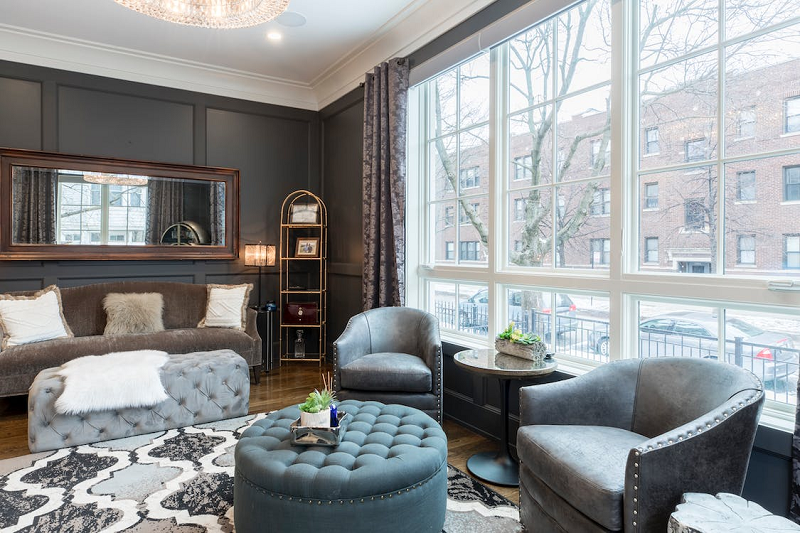
Small Space? 10 Ways To Make A Room Appear Bigger
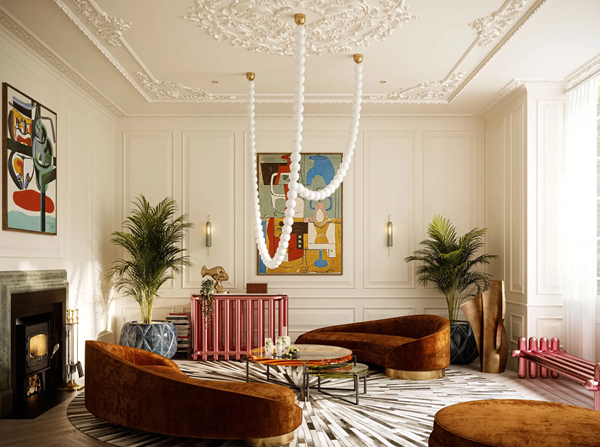
Make Your space Look Expensive
GET CAUGHT UP ON ALL THE INSPIRING DECOR TIPS:
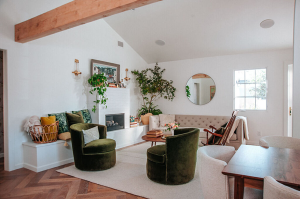
18 Fresh Decorating Ideas To Update Your Fireplace

How To Create An Art Gallery Wall

